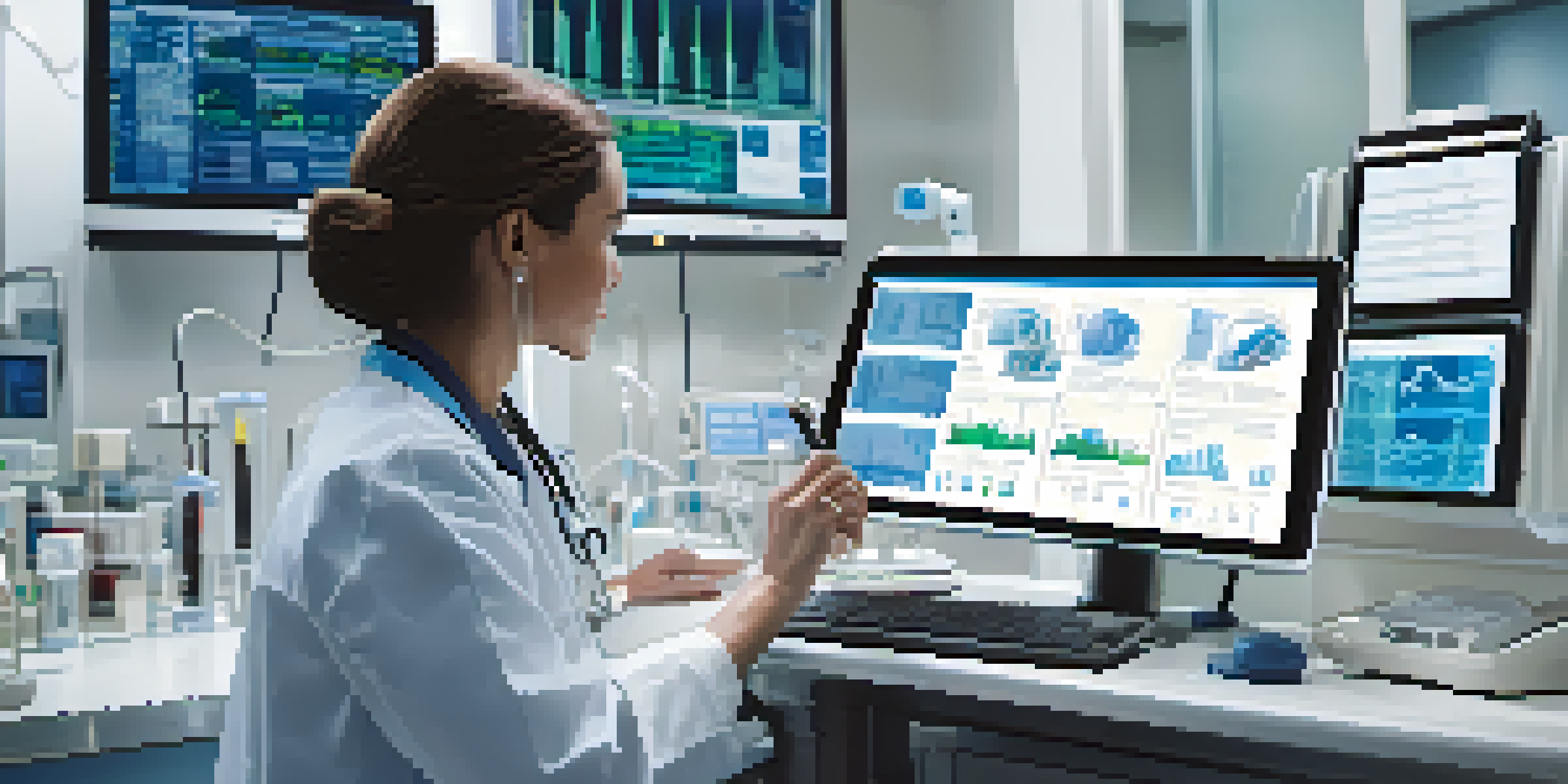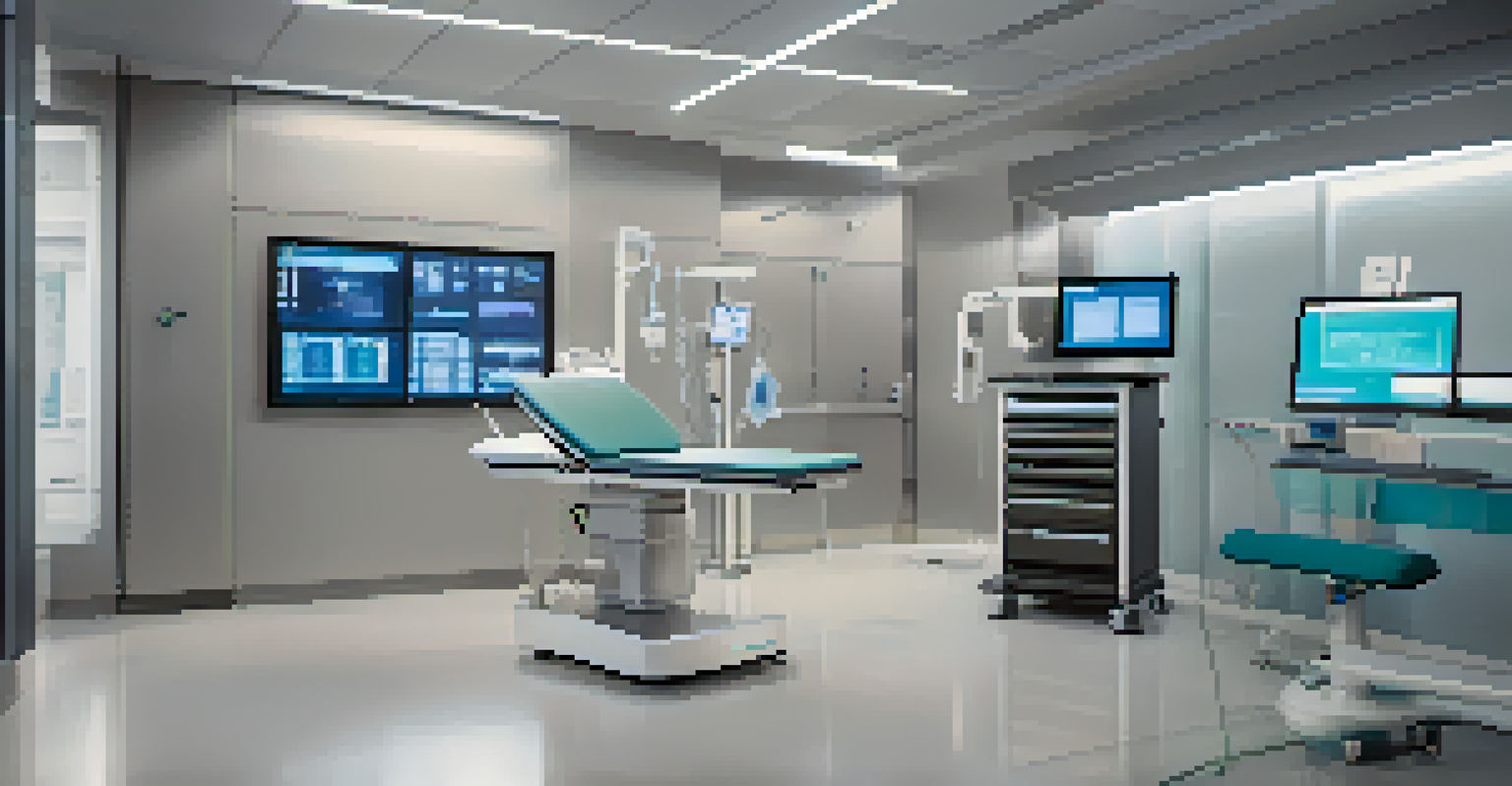Edge Computing in Healthcare: Transforming Patient Care

Understanding Edge Computing in Healthcare Context
Edge computing refers to processing data closer to its source rather than relying on a centralized data center. In healthcare, this means analyzing patient data right at the point of care—like in hospitals or clinics—rather than sending it off to distant servers. This immediate processing can lead to quicker insights and better decision-making for patient care, enhancing the overall efficiency of healthcare delivery.
The future of healthcare lies in leveraging technology to provide timely and personalized care to patients.
Imagine a doctor receiving real-time data from a patient's wearable device. Instead of waiting for data to travel to a server and back, edge computing allows that information to be analyzed instantly. This immediacy can be the difference between timely interventions and missed opportunities, particularly in critical care situations.
As the healthcare landscape evolves, incorporating edge computing could help streamline operations, improve patient outcomes, and reduce costs. With the right technologies in place, healthcare providers can harness this power to deliver personalized care more efficiently.
Enhancing Patient Monitoring with Edge Technology
One of the most significant benefits of edge computing is its ability to enhance patient monitoring. Through devices that collect real-time data—such as heart rate, blood pressure, and oxygen levels—healthcare providers can monitor patients continuously without the delays associated with traditional cloud computing. This level of vigilance is especially crucial for patients in intensive care units or those with chronic conditions.

For instance, a wearable heart monitor can instantly alert healthcare teams if it detects any irregularities. This immediate feedback loop allows for prompt interventions, potentially saving lives. Moreover, it reduces the burden on healthcare professionals, enabling them to focus their efforts where they're most needed.
Real-Time Data Enhances Care
Edge computing allows healthcare providers to access and analyze patient data instantly, leading to quicker decision-making and improved patient outcomes.
The agility provided by edge computing in patient monitoring not only contributes to better health outcomes but also fosters a sense of security for patients and their families. Knowing that their vital signs are being continuously monitored can significantly ease anxiety during critical medical situations.
Improving Telemedicine with Edge Computing Solutions
Telemedicine has gained immense popularity, especially in recent years. Edge computing enhances this trend by ensuring that virtual consultations run smoothly and efficiently. By processing data locally, healthcare providers can minimize latency, resulting in clearer video feeds and faster response times during remote consultations.
Edge computing brings us closer to the patient, enabling real-time data processing that can save lives.
Consider a rural patient accessing specialist care through a telemedicine platform. With edge computing, their medical history and current health data can be accessed and analyzed in real-time, facilitating informed discussions with the specialist. This seamless experience is crucial to maintaining the quality of care, regardless of geographical barriers.
Moreover, using edge computing in telemedicine can help alleviate the strain on central servers, enabling them to handle more users simultaneously. As telemedicine continues to grow, the integration of edge computing will be pivotal in creating a sustainable and effective model for remote healthcare delivery.
Streamlining Data Management through Edge Solutions
Healthcare generates vast amounts of data daily, from patient records to imaging results. Managing this data efficiently is crucial, and edge computing can play a significant role in streamlining these processes. By processing data at the edge, healthcare facilities can reduce the volume of data that needs to be sent to centralized systems, thus optimizing storage and processing resources.
For example, an imaging device can process scans locally, identifying any abnormalities before sending essential information to the main database. This reduces bandwidth usage and ensures that only critical data is transmitted, speeding up the overall workflow and reducing the potential for bottlenecks in patient care.
Improved Patient Monitoring
By enabling continuous real-time monitoring through edge devices, healthcare professionals can respond promptly to critical changes in a patient's condition.
Furthermore, efficient data management ultimately enhances patient privacy and security. By minimizing the amount of data transferred, the risk of breaches decreases, fostering trust between patients and healthcare providers in an increasingly digital world.
Facilitating Real-Time Decision Making with Edge Computing
In the fast-paced environment of healthcare, timely decision-making can be a matter of life and death. Edge computing supports this by providing healthcare professionals with instant access to relevant patient data. This capability allows doctors and nurses to make informed decisions quickly, particularly in emergency situations where every second counts.
Imagine a paramedic on the scene of an accident who can access a patient's medical history instantly through an edge device. This immediate access can guide them in administering the correct treatment or medication, significantly improving patient outcomes. In this way, edge computing acts as a critical resource in emergency care scenarios.
By empowering healthcare professionals with real-time data, edge computing not only enhances individual patient care but also improves overall healthcare system efficiency. As more healthcare providers adopt these technologies, we can expect a shift towards more proactive and responsive care.
Supporting Data Security and Compliance in Healthcare
Data security is a top priority in healthcare, where sensitive patient information is constantly at risk. Edge computing can enhance data security by minimizing the amount of data transmitted over networks. By processing data locally, the system reduces exposure to potential threats during data transfer, thereby safeguarding patient information.
Moreover, edge computing can facilitate compliance with regulations such as HIPAA (Health Insurance Portability and Accountability Act). By keeping sensitive data local, healthcare providers can more easily control who has access to patient information, ensuring that they meet stringent privacy regulations.
Stronger Data Security Measures
Edge computing reduces the amount of data transmitted over networks, enhancing patient privacy and compliance with healthcare regulations.
This added layer of security not only protects patients but also instills confidence in healthcare systems. When patients know their data is handled securely, they are more likely to engage with healthcare providers and share necessary information, creating a more open and trusting healthcare environment.
The Future of Patient Care with Edge Computing
Looking ahead, edge computing promises to reshape the future of patient care significantly. As technology continues to advance, we can expect even more innovative applications of edge computing in healthcare. From AI-driven diagnostics to enhanced robotic surgeries, the possibilities are endless.
With a strong foundation in real-time data processing and analysis, edge computing will enable healthcare providers to offer more personalized and efficient care. Patients can look forward to treatments tailored to their specific conditions, leading to better health outcomes and overall satisfaction.

As the healthcare industry embraces these technologies, it will be vital for stakeholders to collaborate and invest in edge computing infrastructures. By doing so, we can create a future where healthcare is not only smarter but also more responsive to the needs of patients.